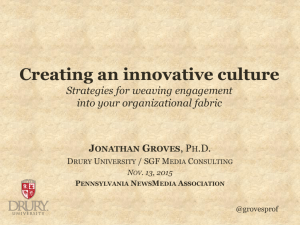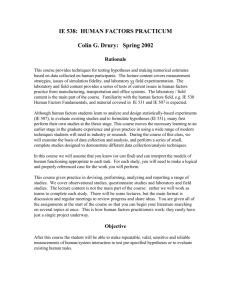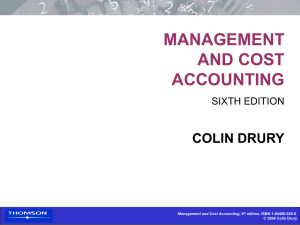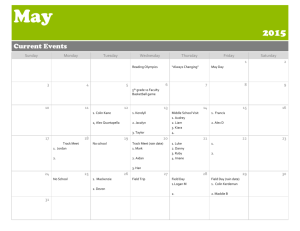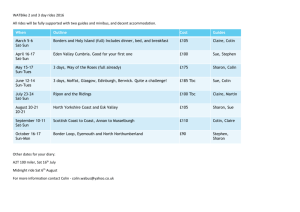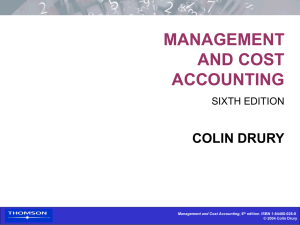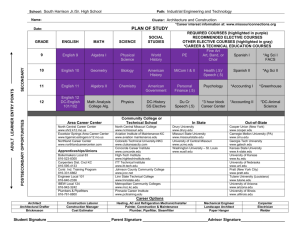ABC 1 File
advertisement
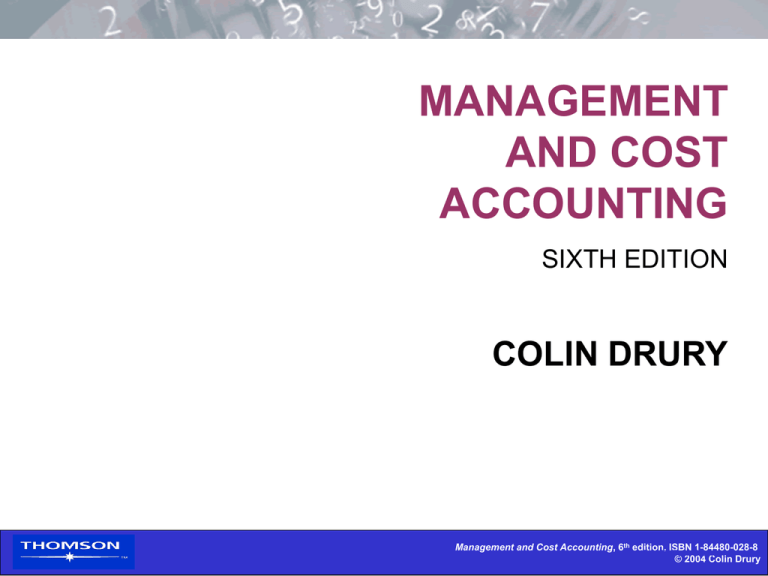
MANAGEMENT AND COST ACCOUNTING SIXTH EDITION COLIN DRURY Management and Cost Accounting, 6th edition, ISBN 1-84480-028-8 © 2000 Colin Drury © 2004 Colin Drury Part Three: Information for decision-making Chapter Ten: Activity based costing Management and Cost Accounting, 6th edition, ISBN 1-84480-028-8 © 2000 Colin Drury © 2004 Colin Drury 10.1a Generating relevant cost information • There are 3 main reasons why a cost accumulation system is required to generate relevant cost information: 1. Many indirect costs are relevant for decision-making: • The cost of many joint resources (e.g.support function costs)fluctuate according to the demand for them. • Product introduction, discontinuation, redesign decisions determine the demand for support function resources and thus future costs. • Costs of support functions are difficult to trace directly to cost objects. Management and Cost Accounting, 6th edition, ISBN 1-84480-028-8 © 2000 Colin Drury © 2004 Colin Drury 10.1b 2. An attention directing system is required to identify potentially unprofitable products that require more detailed special studies: • It is not feasible to periodically undertake special studies for all products or combination of product mixes. 3. Many product-related decisions are not independent: • Focusing only on individual products ignores impact that the culmination of many decisions will have on those joint resources that fluctuate according to the demand for them. Management and Cost Accounting, 6th edition, ISBN 1-84480-028-8 © 2000 Colin Drury © 2004 Colin Drury 10.2 Types of cost systems • Direct costing systems: 1 .Indirect costs are not assigned to cost objects so that only contributions to indirect costs are reported. 2. Appropriate where the majority of costs are direct. 3. Require that indirect costs are incorporated at the special study stage. • Traditional costing systems: 1. Use unsophisticated methods to allocate indirect costs to cost objects. • ABC systems: 1. Use sophisticated methods to allocate indirect costs to cost objects. Management and Cost Accounting, 6th edition, ISBN 1-84480-028-8 © 2000 Colin Drury © 2004 Colin Drury 10.3 A comparison of traditional and ABC systems • Both systems use the two-stage allocation process. • In the first stage traditional systems tend to allocate costs to departments whereas ABC systems allocate costs to activities: (ABC systems tend to have more cost centres/cost pools) • In the second stage traditional systems rely on a small number of volume-based cost drivers (typically direct labour or machine hours) whereas ABC systems use many second stage cost drivers. • ABC systems seek to use only cause-and-effect cost drivers whereas traditional systems often rely on arbitrary allocation bases. • ABC systems tend to establish separate cost driver rates for support departments whereas traditional systems merge support and production centre costs. Management and Cost Accounting, 6th edition, ISBN 1-84480-028-8 © 2000 Colin Drury © 2004 Colin Drury 10.4 A two-stage allocation process (traditional costing system) Management and Cost Accounting, 6th edition, ISBN 1-84480-028-8 © 2000 Colin Drury © 2004 Colin Drury 10.5 The two-stage allocation process (ABC System) Management and Cost Accounting, 6th edition, ISBN 1-84480-028-8 © 2000 Colin Drury © 2004 Colin Drury 10.6 The emergence of ABC systems • Traditional systems were appropriate when: 1. Direct costs were the dominant costs 2. Indirect costs were relatively small 3. Information costs were high 4. There was a lack of intense global competition 5. A limited range of products was produced. Management and Cost Accounting, 6th edition, ISBN 1-84480-028-8 © 2000 Colin Drury © 2004 Colin Drury 10.7a Errors from relying on misleading product costs • Traditional costing systems use volume-based (e.g.direct labour and machine hours) second stage drivers but if volume bases are not the cause of indirect costs reported costs will be misleading. Example Products HV (a high volume product)and LV (a low volume product)are two of several products produced by a company. HV is made in large batches and LV is made in small batches. HV consumes 30%of DLH ’s and LV consumes 5% but each product consumes 15%of the batch-related indirect costs.The traditional system uses DLH ’s as the cost driver and the ABC system uses the number of batches processed. All overheads (total =£1m)are batch-related . Management and Cost Accounting, 6th edition, ISBN 1-84480-028-8 © 2000 Colin Drury © 2004 Colin Drury 10.7b • Reported product costs: • Traditional system reports misleading information —In the longer term overheads will not decline by £300 000 if HV is discontinued. • ABC allocates on a cause-and-effect basis and shows high level of resources consumed by LV —The 2 costing systems report different messages (Traditional =Drop HV ABC =Drop LV). •Traditional system motivates the wrong strategy. Management and Cost Accounting, 6th edition, ISBN 1-84480-028-8 © 2000 Colin Drury © 2004 Colin Drury 10.8 Designing ABC systems 1. Identify the major activities that take place in an organization: • The activities chosen should be at a reasonable level of aggregation based on cost/benefit criteria. • Choice of activities influenced by the total cost of theactivity centre and the ability of a single cost driver to provide a satisfactory determinant of the cost of the activity. Management and Cost Accounting, 6th edition, ISBN 1-84480-028-8 © 2000 Colin Drury © 2004 Colin Drury 10.8b Designing ABC systems (contd.) 2. Assign costs to cost pools /cost centre for each activity: • Costs assigned to activity cost pools will include direct and indirect costs. • Resource cost drivers used to assign indirect costs. • Reliability of cost information will be reduced if arbitrary allocations are used to assign a significant proportion of costs to activities. Management and Cost Accounting, 6th edition, ISBN 1-84480-028-8 © 2000 Colin Drury © 2004 Colin Drury 10.8c Designing ABC systems (contd.) 3. Determine the cost driver for each major activity: • Drivers at this stage called activity drivers.They should: (a) provide a good explanation of costs of each activity pool. (b) be easily measurable (c) the data should be easy to obtain and identifiable with the product. • Activity cost drivers consist of three types (Transaction, duration and intensity drivers). 4. Assign the cost of activities to products: • The cost driver must be measurable so that it can be identified with individual products. Management and Cost Accounting, 6th edition, ISBN 1-84480-028-8 © 2000 Colin Drury © 2004 Colin Drury 10.9a Classification of activities • Unit-level activities: 1. 2. 3. Performed each time a unit of the product or service is produced. Resources are consumed in proportion to the number of units produced or sold. Examples —Direct materials and labour,energy costs and expenses consumed in proportion to machine processing time. • Batch-related activities: 1. 2. 3. Performed each time a batch of goods is produced. Costs vary with the number of batches made. Examples include set-ups, purchase ordering and first-item inspection activities. Management and Cost Accounting, 6th edition, ISBN 1-84480-028-8 © 2000 Colin Drury © 2004 Colin Drury 10.9b Classification of activities contd. • Product/service sustaining activities: 1. 2. Performed to enable the production of individual products or services. Examples include activities related to maintaining an accurate bill of materials, preparing engineering change notices. • Facility-sustaining (or business-sustaining) activities: 1. 2. 3. Performed to support the organization as a whole. Examples include plant management,property costs and salaries of general administrative staff. Common to all products and services –.not allocated to products/services. Management and Cost Accounting, 6th edition, ISBN 1-84480-028-8 © 2000 Colin Drury © 2004 Colin Drury 10.10 Activity-based profitability analysis • Applies ABC hierarchical activity classification to profitability analysis. • Used for attention directing —claimed provides more accurate information. • Hierarchical approach can be applied to different cost objects (e.g. products/services, customers, locations.) • See sheet 11 for an illustration of the ABC hierarchical profitability analysis. • Aim is to assign all organizational expenses to a particular hierarchical level where cause-and-effect cost assignments can be established. • The approach helps to identify the impact of resource consumption of adding or dropping items at each level of the hierarchy. Management and Cost Accounting, 6th edition, ISBN 1-84480-028-8 © 2000 Colin Drury © 2004 Colin Drury 10.11 (Fig 10.2) An illustration of hierarchical profitability analysis) Management and Cost Accounting, 6th edition, ISBN 1-84480-028-8 © 2000 Colin Drury © 2004 Colin Drury 10.12a Resource consumption models • ABC systems measure the cost of using resources and not the cost of supplying resources: Cost of resources = Cost of resources + Cost of unused Supplied used capacity • Periodic financial statements measure the cost of resources supplied (i.e.15 000 orders at a cost of £300 000 in Example10.2). • ABC systems measure the cost of resources used (i.e.13 000 orders at a cost of £20 per order in Example 10.2). • The difference between the cost of resources supplied and the cost of resources used represents the cost of unused capacity (i.e.2 000 orders at £20 per order =£40 000) Management and Cost Accounting, 6th edition, ISBN 1-84480-028-8 © 2000 Colin Drury © 2004 Colin Drury 10.12b • Unused capacity arises with committed resources because they must be acquired in discrete amounts in advance of usage. • With flexible resources supply can be continually adjusted to match exactly the usage of resources. • Managers make decisions that will result in a change of activity usage (e.g.discontinuation decisions reduce cost of resources used and increase the cost of unused capacity). • Cash flow consequences will only arise if action is taken to remove unused capacity by reducing spending on the supply of resources. • The periodic reporting of unused capacity signals the need for a change in the spending on the supply of resources. Management and Cost Accounting, 6th edition, ISBN 1-84480-028-8 © 2000 Colin Drury © 2004 Colin Drury 10.13 Example 10.2 (1) Resources supplied 10 staff at £30 000 per year Cost driver Annual quantity of cost driver supplied: (1 500 orders per employee) Estimated cost driver rate (2) Resources used Estimated annual number of orders to be processed Estimated cost of resources used assigned to parts/ materials (3) Cost of unused capacity Resources supplied (15 000) –Resources used (13 000) at £20 per order = £300 000 annual activity cost = Number of orders processed = 15 000 purchase orders = £20 per purchase order (£300 000/15 000 orders) = 13 000 = £260 000 (13 000*£20) = £40 000 (2 000*£20) Management and Cost Accounting, 6th edition, ISBN 1-84480-028-8 © 2000 Colin Drury © 2004 Colin Drury 10.14 Selecting the cost driver denominator level • The correct denominator activity level to use is the level of capacity supplied (practical capacity)and not the anticipated usage. • Using anticipated usage in Example 10.2 would result in a cost driver rate of £23.08 (£300 000/13 000)so that the cost of unused capacity will be hidden in the cost driver rate rather than being separately reported. • Using anticipated usage would result in high cost driver rates in periods of low sales demand. The ABC data base • Ideally maintained at estimated standard costs and periodically reviewed. • In addition a cost and profitability audit of a firm’s products,customers and sales outlets should be periodically undertaken. Management and Cost Accounting, 6th edition, ISBN 1-84480-028-8 © 2000 Colin Drury © 2004 Colin Drury 10.15a ABC cost management applications • ABC can be used for a range of cost management applications besides product costing. Management and Cost Accounting, 6th edition, ISBN 1-84480-028-8 © 2000 Colin Drury © 2004 Colin Drury 10.15b Criticisms of ABC • ABC unit costs must be used with care —They can suggest an inappropriate degree of variability. • The concept of unused capacity within the resource consumption model is questionable for physical resources. • Reported costs may not significantly differ from a less costly traditional system if indirect costs are a low proportion of total costs. Management and Cost Accounting, 6th edition, ISBN 1-84480-028-8 © 2000 Colin Drury © 2004 Colin Drury
